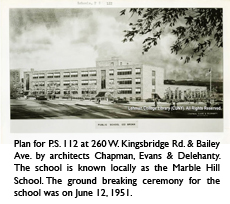Kingsbridge

The first bridge to Manhattan, over which for nearly a century all land traffic was obliged to pass, stood near what is today the corner of Kingsbridge Avenue and 230th Street, then the bank of Spuyten Duyvel Creek. The short wooden structure was built in 1693 by Frederick Phillipse, lord of Phillipse Manor, whose royal patent justified the name "King's Bridge" and the imposition of highly-resented tolls. A colonial attempt to break the stranglehold, the building of a Farmer's Free Bridge [1759] just to the southeast, showed Phillipseburgh interests which way things were headed. After the Revolution, the Tory manor was seized and divested of its rights.
In the eighteenth century a village had grown up at the bridgehead, feeding and supplying cattle drovers and carters who stopped at the tollgate. Kingsbridge in the nineteenth century came under the control of Yonkers, and later annexed itself to New York City. Serving the nearby Johnson Iron Foundry and offering a depot on the New York Central railroad, the town, centered on 230th street (called Riverdale Avenue), prospered in its rural setting until the Broadway line of the IRT subway was completed in 1907, and urbanization of the area began. By 1923, a canal had been cut almost a mile to the south, and the old creek filled in, leaving the site of the King's Bridge high and dry.
[Back to Index]